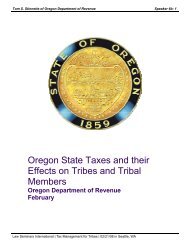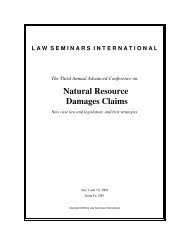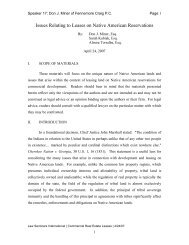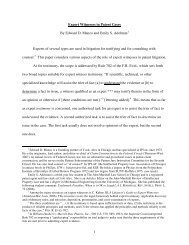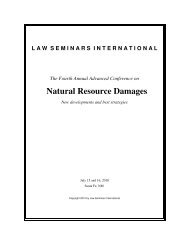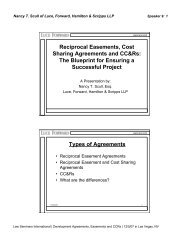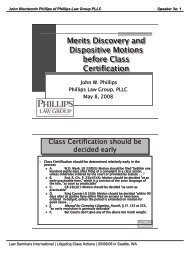LSI 2010 Real Estate Joint Ventures conference materials.pdf
LSI 2010 Real Estate Joint Ventures conference materials.pdf
LSI 2010 Real Estate Joint Ventures conference materials.pdf
Create successful ePaper yourself
Turn your PDF publications into a flip-book with our unique Google optimized e-Paper software.
John W. Hanley, Jr. of Davis Wright Tremaine LLP<br />
Tom Tierney of Seattle Housing Authority<br />
Gary A. Young of Polygon Northwest Company<br />
Hal Ferris of Spectrum Development Solutions LLC<br />
Speaker 13: 1<br />
Speaker 14: 1<br />
Speaker 15: 1<br />
Speaker 16: 1<br />
Large-scale Residential Development in Public-Private Partnership<br />
Meeting the goals of both the public and private sectors<br />
Tom Tierney, Executive Director, Seattle Housing Authority<br />
Gary Young, Sr. Vice President and Co-Owner, Polygon Northwest Co.<br />
Hal Ferris, Principal, Spectrum Development Solutions<br />
Moderated by John Hanley, Partner, Davis Wright Tremaine LLP<br />
The public or private sector: which one “does it better?”<br />
From the volume at which partisans argue the question, one might think there could<br />
actually be an answer. But increasingly, the people who have to move large capital<br />
projects forward understand that a partnership between the public and private sectors<br />
provides benefits that neither sector can achieve alone. For the implementation of a wide<br />
variety of large capital projects, from water supply facilities to transportation<br />
improvements, from schools to housing, the public sector is turning to joint ventures<br />
with the private sector through public-private partnerships.<br />
A public-private partnership is “a contractual agreement between a public agency<br />
(federal, state, or local) and a private sector entity. Through this agreement the skills and<br />
assets of each sector (public and private) are shared in delivering a service or facility for<br />
the use of the public. In addition to the sharing of resources, each party shares in the risks<br />
and rewards potential in the delivery of the service and/or facility.” (Source:<br />
www.ncppp.org.)<br />
To be successful, such a partnership must build on the special strengths of each of the<br />
parties, it must fulfill the unique needs of the parties, and it must balance the distribution<br />
of risks and rewards between the parties. In the February 8 <strong>LSI</strong> session on Large-Scale<br />
Residential Development in Public-Private Partnership, we examine what two parties –<br />
Seattle Housing Authority (SHA) and Polygon Homes – were seeking through a<br />
partnership in SHA’s award-winning High Point development, and we explore what<br />
potential partners may desire in the distribution of the risks and rewards in a much<br />
denser urban development being planned for Yesler Terrace.<br />
Even though these case studies are focused on public-private residential development,<br />
many of the ideas are transferable to other potential partnerships. The advantages we seek<br />
through partnership in these residential settings are similar to the advantages sought<br />
whenever the public sector reaches to a private partner to deliver a project. The National<br />
Council for Public-Private Partnerships lists some of these advantages as follows:<br />
maximize the use of each sector’s strength, reduce development risk, reduce public capital<br />
Law Seminars International | <strong>Real</strong> <strong>Estate</strong> <strong>Joint</strong> <strong>Ventures</strong> and Funds | 02/08/10 in Seattle, WA




